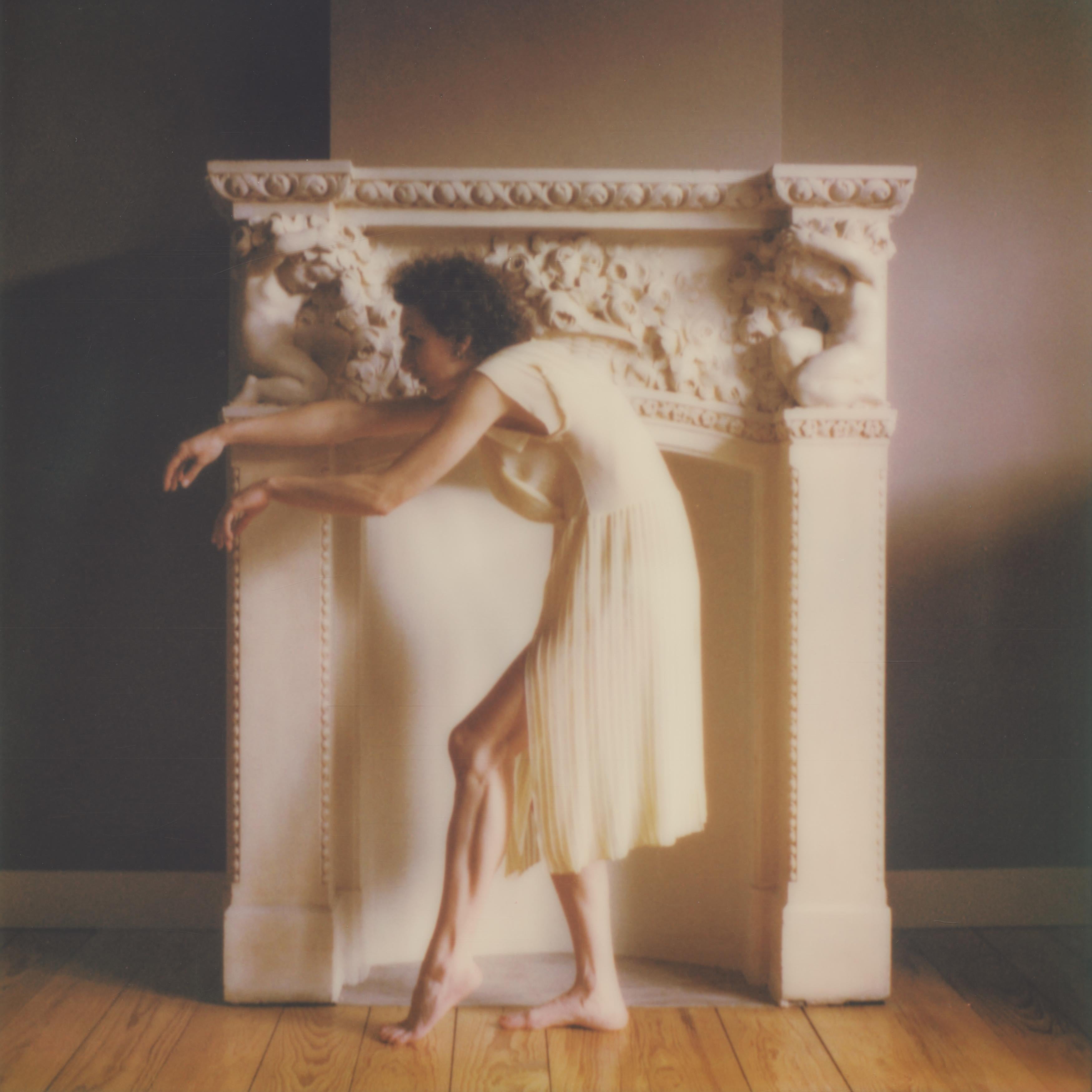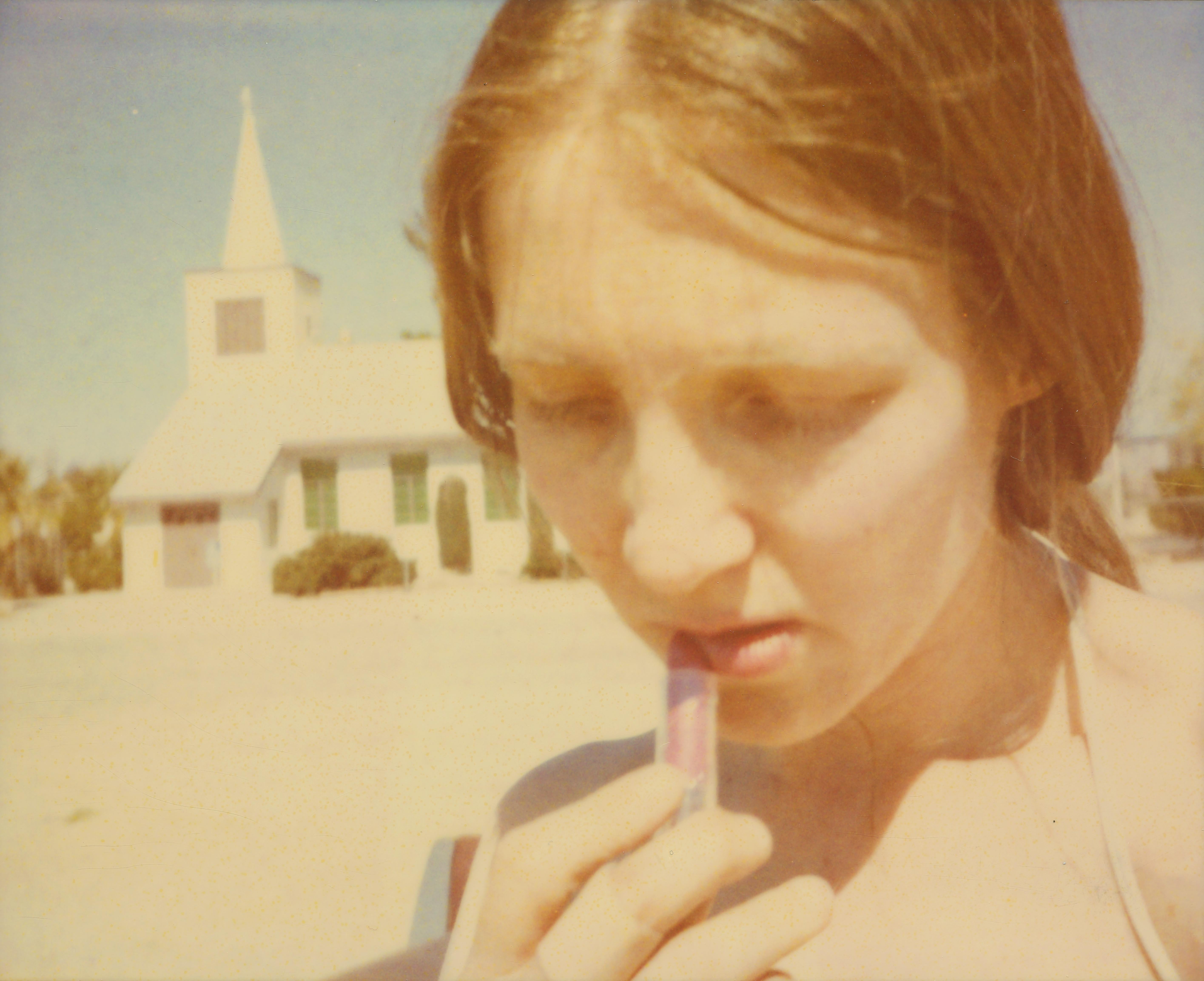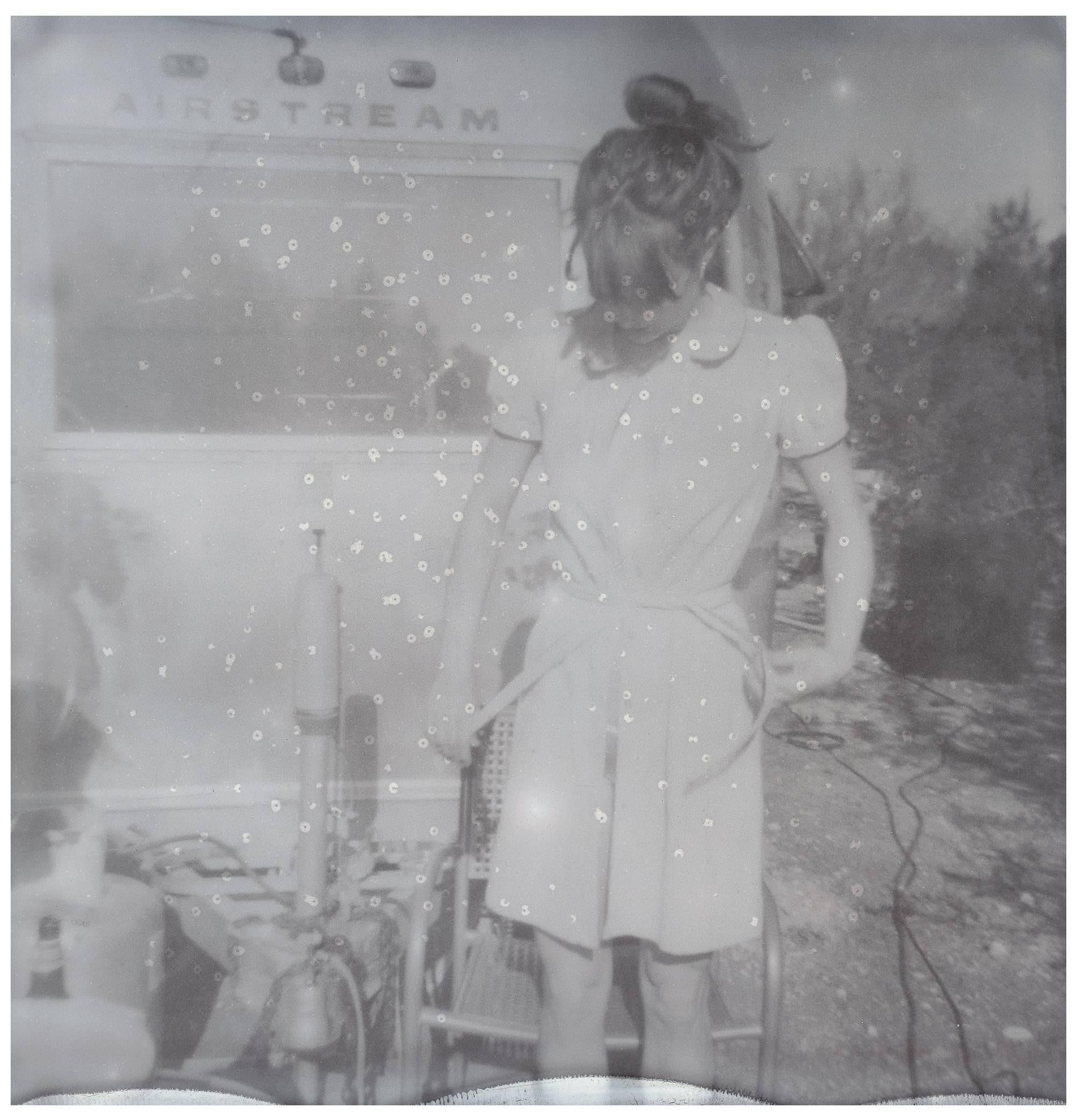Items Similar to Girl at Fence III (The Last Picture Show)
Want more images or videos?
Request additional images or videos from the seller
1 of 5
Stefanie SchneiderGirl at Fence III (The Last Picture Show)2005
2005
About the Item
Girl at Fence III (The Last Picture Show) - 2005,
58x56cm.
Edition 2/5.
Analog C-Print, hand-printed by the artist, based on the Polaroid.
Certificate and Signature label.
Artist Inventory #1041.02.
Not mounted.
LIFE’S A DREAM
(The Personal World of Stefanie Schneider)
Projection is a form of apparition that is characteristic of our human nature, for what we imagine almost invariably transcends the reality of what we live. And, an apparition, as the word suggests, is quite literally ‘an appearing’, for what we appear to imagine is largely shaped by the imagination of its appearance. If this sounds tautological then so be it. But the work of Stefanie Schneider is almost invariably about chance and apparition. And, it is through the means of photography, the most apparitional of image-based media, that her pictorial narratives or photo-novels are generated. Indeed, traditional photography (as distinct from new digital technology) is literally an ‘awaiting’ for an appearance to take place, in line with the imagined image as executed in the camera and later developed in the dark room. The fact that Schneider uses out-of-date Polaroid film stock to take her pictures only intensifies the sense of their apparitional contents when they are realised. The stability comes only at such time when the images are re-shot and developed in the studio, and thereby fixed or arrested temporarily in space and time.
The unpredictable and at times unstable film she adopts for her works also creates a sense of chance within the outcome that can be imagined or potentially envisaged by the artist Schneider. But this chance manifestation is a loosely controlled, or, better called existential sense of chance, which becomes pre-disposed by the immediate circumstances of her life and the project she is undertaking at the time. Hence the choices she makes are largely open-ended choices, driven by a personal nature and disposition allowing for a second appearing of things whose eventual outcome remains undefined. And, it is the alliance of the chance-directed material apparition of Polaroid film, in turn explicitly allied to the experiences of her personal life circumstances, that provokes the potential to create Stefanie Schneider’s open-ended narratives. Therefore they are stories based on a degenerate set of conditions that are both material and human, with an inherent pessimism and a feeling for the sense of sublime ridicule being seemingly exposed. This in turn echoes and doubles the meaning of the verb ‘to expose’. To expose being embedded in the technical photographic process, just as much as it is in the narrative contents of Schneider’s photo-novel exposés. The former being the unstable point of departure, and the latter being the uncertain ends or meanings that are generated through the photographs doubled exposure.
The large number of speculative theories of apparition, literally read as that which appears, and/or creative visions in filmmaking and photography are self-evident, and need not detain us here. But from the earliest inception of photography artists have been concerned with manipulated and/or chance effects, be they directed towards deceiving the viewer, or the alchemical investigations pursued by someone like Sigmar Polke. None of these are the real concern of the artist-photographer Stefanie Schneider, however, but rather she is more interested with what the chance-directed appearances in her photographs portend. For Schneider’s works are concerned with the opaque and porous contents of human relations and events, the material means are largely the mechanism to achieving and exposing the ‘ridiculous sublime’ that has come increasingly to dominate the contemporary affect(s) of our world. The uncertain conditions of today’s struggles as people attempt to relate to each other - and to themselves - are made manifest throughout her work. And, that she does this against the backdrop of the so-called ‘American Dream’, of a purportedly advanced culture that is Modern America, makes them all the more incisive and critical as acts of photographic exposure.
From her earliest works of the late nineties one might be inclined to see her photographs as if they were a concerted attempt at an investigative or analytic serialisation, or, better still, a psychoanalytic dissection of the different and particular genres of American subculture. But this is to miss the point for the series though they have dates and subsequent publications remain in a certain sense unfinished. Schneider’s work has little or nothing to do with reportage as such, but with recording human culture in a state of fragmentation and slippage. And, if a photographer like Diane Arbus dealt specifically with the anomalous and peculiar that made up American suburban life, the work of Schneider touches upon the alienation of the commonplace. That is to say how the banal stereotypes of Western Americana have been emptied out, and claims as to any inherent meaning they formerly possessed has become strangely displaced. Her photographs constantly fathom the familiar, often closely connected to traditional American film genre, and make it completely unfamiliar. Of course Freud would have called this simply the unheimlich or uncanny. But here again Schneider almost never plays the role of the psychologist, or, for that matter, seeks to impart any specific meanings to the photographic contents of her images. The works possess an edited behavioural narrative (she has made choices), but there is never a sense of there being a clearly defined story. Indeed, the uncertainty of my reading here presented, acts as a caveat to the very condition that Schneider’s photographs provoke.
Invariably the settings of her pictorial narratives are the South West of the United States, most often the desert and its periphery in Southern California. The desert is a not easily identifiable space, with the suburban boundaries where habitation meets the desert even more so. There are certain sub-themes common to Schneider’s work, not least that of journeying, on the road, a feeling of wandering and itinerancy, or simply aimlessness. Alongside this subsidiary structural characters continually appear, the gas station, the automobile, the motel, the highway, the revolver, logos and signage, the wasteland, the isolated train track and the trailer. If these form a loosely defined structure into which human characters and events are cast, then Schneider always remains the fulcrum and mechanism of their exposure. Sometimes using actresses, friends, her sister, colleagues or lovers, Schneider stands by to watch the chance events as they unfold. And, this is even the case when she is a participant in front of camera of her photo-novels. It is the ability to wait and throw things open to chance and to unpredictable circumstances, that marks the development of her work over the last eight years. It is the means by which random occurrences take on such a telling sense of pregnancy in her work.
However, in terms of analogy the closest proximity to Schneider’s photographic work is that of film. For many of her titles derive directly from film, in photographic series like OK Corral (1999), Vegas (1999), Westworld (1999), Memorial Day (2001), Primary Colours (2001), Suburbia (2004), The Last Picture Show (2005), and in other examples. Her works also include particular images that are titled Zabriskie Point, a photograph of her sister in an orange wig. Indeed the tentative title for the present publication Stranger Than Paradise is taken from Jim Jarmusch’s film of the same title in 1984. Yet it would be dangerous to take this comparison too far, since her series 29 Palms (1999) presages the later title of a film that appeared only in 2002. What I am trying to say here is that film forms the nexus of American culture, and it is not so much that Schneider’s photographs make specific references to these films (though in some instances they do), but that in referencing them she accesses the same American culture that is being emptied out and scrutinised by her photo-novels. In short her pictorial narratives might be said to strip films of the stereotypical Hollywood tropes that many of them possess. Indeed, the films that have most inspired her are those that similarly deconstruct the same sentimental and increasingly tawdry ‘American Dream’ peddled by Hollywood. These include films like David Lynch’s Blue Velvet (1986), Wild at Heart (1990) The Lost Highway (1997), John Dahl’s The Last Seduction (1994) or films like Ridley Scott’s Thelma and Louise with all its girl-power Bonny and Clyde-type clichés. But they serve no more than as a backdrop, a type of generic tableau from which Schneider might take human and abstracted elements, for as commercial films they are not the product of mere chance and random occurrence.
Notwithstanding this observation, it is also clear that the gender deconstructions that the characters in these films so often portray, namely the active role of women possessed of a free and autonomous sexuality (even victim turned vamp), frequently find resonances within the behavioural events taking place in Schneider’s photographs and DVD sequences; the same sense of sexual autonomy that Stefanie Schneider possesses and is personally committed to....
- Creator:Stefanie Schneider (1968, German)
- Creation Year:2005
- Dimensions:Height: 22.84 in (58 cm)Width: 22.45 in (57 cm)Depth: 0.04 in (1 mm)
- Medium:
- Movement & Style:
- Period:
- Condition:
- Gallery Location:Morongo Valley, CA
- Reference Number:1stDibs: LU652313511532
About the Seller
4.9
Platinum Seller
These expertly vetted sellers are 1stDibs' most experienced sellers and are rated highest by our customers.
Established in 1996
1stDibs seller since 2017
953 sales on 1stDibs
Typical response time: 2 hours
- ShippingRetrieving quote...Ships From: Morongo Valley, CA
- Return PolicyA return for this item may be initiated within 7 days of delivery.
More From This SellerView All
- Tales of Bitter Doom #14By Carmen de VosLocated in Morongo Valley, CA'Tales of Bitter Doom #14' by Carmen De Vos, Edition of 7, 30x30cm, 2018 digital c-print, based on a Polaroid mounted on Dibond - gloss coating, hand sign...Category
2010s Contemporary Figurative Photography
MaterialsC Print, Color, Polaroid
- Reinventing oneself, I - Polaroid, Contemporary, Color, 21st CenturyBy Kirsten Thys van den AudenaerdeLocated in Morongo Valley, CAReinventing oneself, I - 2019, 20x20cm, Edition of 7 plus 2 Artist Proofs. Archival C-Print based on the original Polaroid. Signature label with certificate. Artist inventory ...Category
2010s Contemporary Figurative Photography
MaterialsParchment Paper, Photographic Paper, C Print, Color, Polaroid
- Lipstick (Sidewinder) - 21st Century, Polaroid, Contemporary, Women, PortraitBy Stefanie SchneiderLocated in Morongo Valley, CALipstick (Sidewinder) - 2005 20 x 24 cm, Edition of 10, Archival C-Print based on the Polaroid, signature label and certificate. Artist Inventory 3045. Not mounted. sidewinder "private history turned into an intimate mythology of elemental fantasies where reality is perceived through a veil of psychedelic memories and unconscious projections. such is a collection of passions and dreams, an uncanny diary of ephemeral narratives and mental intensities in Stefanie Schneider’s painterly photographs...Category
Early 2000s Contemporary Figurative Photography
MaterialsArchival Paper, Photographic Paper, C Print, Color, Polaroid
- Alphabet Soup (Till Death do us Part) - mountedBy Stefanie SchneiderLocated in Morongo Valley, CAAlphabet Soup (Till Death do us Part) - 2005, 128x127cm, Edition 2/5, analog C-Print, hand-printed by the artist. based on the Polaroid. Artist Inventory No. 9283.02. Mounted o...Category
Early 2000s Contemporary Portrait Photography
MaterialsMetal
- Girl at Fence III (The Last Picture Show) 20x20cmBy Stefanie SchneiderLocated in Morongo Valley, CAGirl at Fence III (The Last Picture Show) - 2005 20x20cm, Edition of 10, Archival C-Print, based on the Polaroid Certificate and Signature label artist Inventory No. 775.16 Not mo...Category
Early 2000s Contemporary Figurative Photography
MaterialsC Print, Color, Polaroid
- Alphabet Soup (Till Death do us Part)By Stefanie SchneiderLocated in Morongo Valley, CAAlphabet Soup (Till Death do us Part) - 2005, 128x127cm, Edition 3/5, analog C-Print, hand-printed by the artist, based on the Polaroid. Artist Inventory No. 9283.03. Signature ...Category
Early 2000s Contemporary Portrait Photography
MaterialsArchival Paper, Photographic Paper, C Print, Color, Polaroid
You May Also Like
- QE1 1566By Jack PernoLocated in Chicago, ILArchival Pigment Print Edition of 25 Print size: 19 H x 14 W inches Frame size: 26 H x 22 W inches Matted and framed in a beautiful tiger wood frame...Category
Early 2000s Contemporary Portrait Photography
MaterialsArchival Ink, Archival Paper, Archival Pigment, Polaroid
- Elena Madonna 2By Jack PernoLocated in Chicago, ILArchival Pigment Print Edition of 25 Print size: 19 H x 6.5 W inches Frame size: 26 H x 13 W inches This piece is a digital reproduction of an original 8 x 10" polaroid that was m...Category
Early 2000s Contemporary Portrait Photography
MaterialsArchival Paper, Archival Pigment, Polaroid, Archival Ink
- Bartender ShakerBy Nick VeaseyLocated in PARIS, FRX-ray lenticular artwork Lenticular is a ribbed lens that refracts light from different angles. When sequential images are split behind the lenticular lens the image looks like it moves or animates. It is amusing that this motion brings our x-ray of cadavers to life. By creating...Category
2010s Contemporary Portrait Photography
MaterialsC Print, Lenticular
- Hydra (full figure)By Isabelle Van ZeijlLocated in Boca Raton, FL"Flowers are an important source of inspiration for me.", says the artist of this series of work. "These blue Hydrangeas resonate calmness, balance and purifies our energy".Category
21st Century and Contemporary Contemporary Portrait Photography
MaterialsC Print
- Markus Klinko - Diamond Dust - Beyonce, Dangerously in Love, 2003, Printed AfterBy Markus KlinkoLocated in Greenwich, CT20th Anniversary Limited Edition Diamond Dust Print From the photoshoot of the 2003 album Dangerously in Love Diamond Dust - Beyonce, Dangerously in Love (Back) All available sizes...Category
Early 2000s Contemporary Figurative Photography
MaterialsC Print, Color
- Markus Klinko - Diamond Dust - Beyonce, Dangerously in Love, 2003, Printed AfterBy Markus KlinkoLocated in Greenwich, CTFrom the photoshoot of the 2003 album Dangerously in Love All available sizes and editions: 20 x 24 in, Edition of 50 + 8 AP's 33.1 x 40 in, Edition of 25 + 6 AP's 49.5 x 60 in, Edi...Category
Early 2000s Contemporary Figurative Photography
MaterialsC Print, Color





